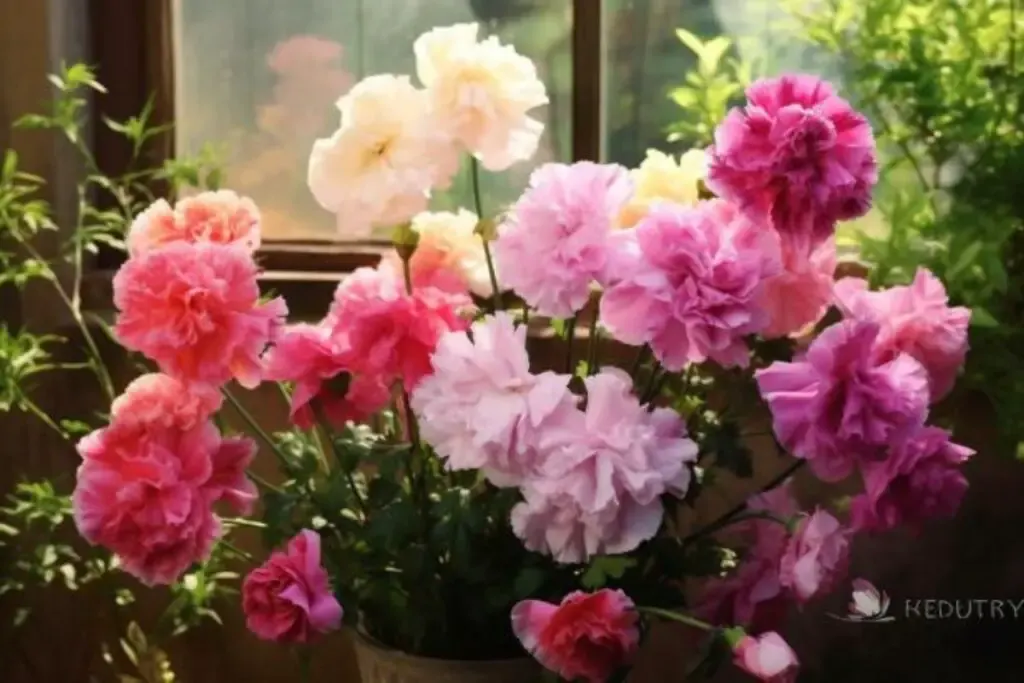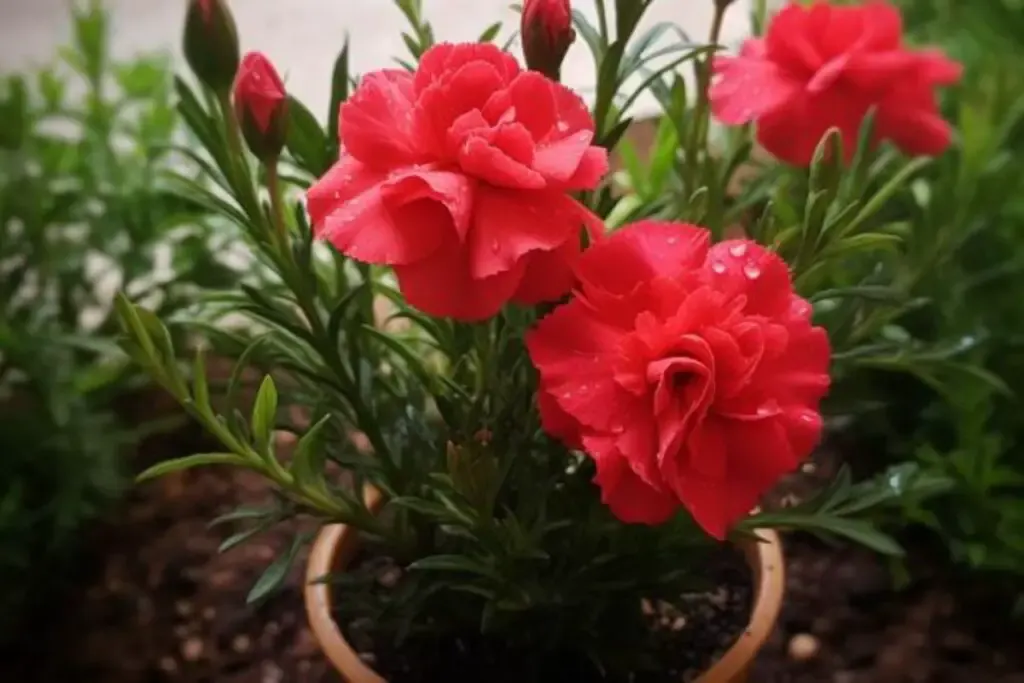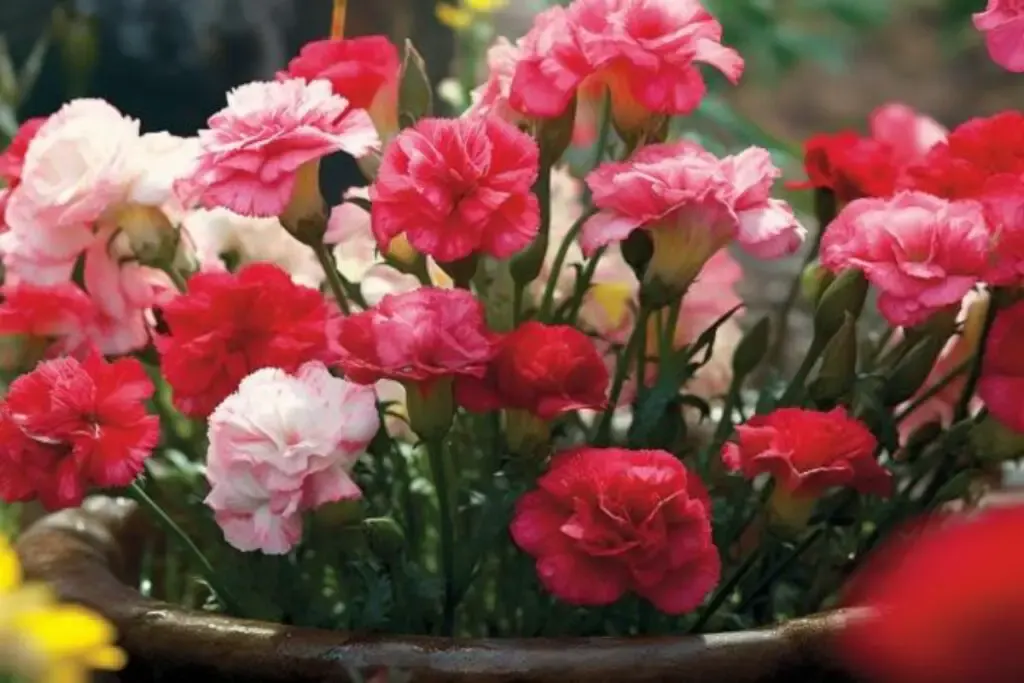Carnations, with their vivid colors and delightful fragrances, are a favorite among flower enthusiasts and gardeners alike. Growing these charming blooms in pots is not only feasible but also a rewarding experience.
Whether you’re an urban dweller with limited space or a seasoned gardener looking to add versatility to your floral displays, this guide will help you master the art of growing carnations in containers.
Do Carnations Grow Well in Pots?
Absolutely! Carnations thrive in container gardens due to their compact size and adaptable root systems. Container cultivation offers enhanced control over growing conditions, simplifies pest and disease management, and allows for easy adjustment of sunlight exposure.
Additionally, potted carnations add vibrant color and charm to patios, balconies, or windowsills.
Best Carnation Varieties for Pots
Not all carnation varieties are created equal, especially when it comes to container gardening. Some are more suited to this method due to their size, growing habits, and overall maintenance needs.
Let’s explore three varieties that are particularly well-suited for pot culture.
1. Chabaud Carnation

The Chabaud Carnation is a popular pot variety known for its full, frilly blooms in diverse colors, adding elegance to any setting.
These carnations are ideal for cutting, lasting long and bringing garden beauty indoors. They thrive in well-draining soil and full sunlight, and their hardiness makes them tolerant of occasional gardening errors.
2. Dwarf Grenadin Carnation

This is ideal for small spaces, offering traditional carnation beauty in a compact size of 12 to 18 inches tall. Ideal for small pots and containers, they bloom in rich colors with a spicy fragrance.
These dwarf varieties are low-maintenance, requiring full sun, regular watering, and well-draining soil, typical of standard carnation care.
3. Hardy Border Carnation

The Hardy Border Carnation is perfect for container gardening, especially for novice gardeners, due to its robustness and adaptability to various conditions. It produces large, fragrant blooms in a range of colors.
These carnations flourish in well-draining soil and full sun, though they can also tolerate partial shade, making them versatile for diverse garden environments.
How to Grow and Care For Carnations in Pots
Growing carnations in pots is not just about picking the right variety; it’s also about providing them with the care they need to thrive.
Here are some expert tips to ensure your potted carnations grow healthy and vibrant.
Planting
Planting carnations in pots is straightforward and enjoyable. Pick a well-draining pot and plant in spring or early fall for optimal growth. Ensure the crown of the plant is slightly above the soil and space them adequately for air circulation.
A good initial watering is key, but remember, carnations prefer not to be too wet. This simple start paves the way for a beautiful bloom display.
Pot Size
Selecting the right pot size is key for growing healthy carnations. Aim for a pot about 12-15 inches in diameter and around 12 inches deep. This size is ideal for root development and ensures good drainage, which is essential for preventing root rot and promoting healthy growth
A well-sized pot also contributes to the overall beauty of your carnation display.
Light
Carnations require at least six hours of bright, direct sunlight each day to flourish. Position your pots in a sunny spot to encourage strong growth and vibrant blooms. In very hot climates, some afternoon shade can help protect the plants from scorching.
Adequate sunlight is essential for the health and color intensity of your carnation flowers.
Soil
The right soil is critical for growing carnations in pots. These flowers prefer well-draining soil, as stagnant water can lead to root rot. A high-quality potting mix works well.
Carnations also like a slightly alkaline to neutral pH. If your soil is too acidic, you can add a bit of lime to adjust it. Ensuring the soil has the right texture and pH not only promotes healthy growth but also contributes to more vibrant blooms.
Water
Watering Carnations is all about finding the sweet spot – they love moisture but despise soggy feet. Aim for evenly moist soil, allowing the top inch to dry out slightly between waterings. This balance ensures your Carnations stay hydrated for optimal growth without risking root rot.
Regular, mindful watering will keep these beauties blooming brightly.
Temperature and Humidity
Carnations enjoy a bit of pampering with the right temperature and humidity. They prefer cooler conditions, thriving best in temperatures around 50-65°F. Moderate humidity suits them well, avoiding environments that are too dry or too damp.
Creating this comfortable balance helps ensure your carnations stay healthy and vibrant.
Fertilizer
Feeding your Carnations is like giving them a regular boost of energy. Use a balanced, all-purpose fertilizer every 6-8 weeks during the growing season. This steady nutrition supports their lush growth and vibrant blooms. Just remember, a little goes a long way in keeping your Carnations flourishing.
Pruning Potted Carnations
Pruning your potted Carnations is like giving them a refreshing haircut. Snip off the spent blooms regularly to encourage more flowers, and trim back the stems after blooming to keep them bushy and full.
A quick, clean cut here and there not only tidies them up but also spurs new growth, ensuring your Carnations are always ready for their next showy display.
Overwintering
Overwintering your plants is like tucking them in for a cozy winter’s rest. As the colder months approach, reduce watering and move them to a cooler, less bright spot. This little winter break helps them conserve energy and come back even stronger for a splendid spring showing.
The ideal overwintering environment has just enough light and a temperature slightly above freezing. Before bringing them indoors, trim back the plants to reduce their energy needs. In the spring, gradually reintroduce your carnations to outdoor conditions to prevent shock. This gradual acclimation ensures your carnations will be ready for a new season of growth and blooming.
As we wrap up this guide on growing carnations in pots, remember that the joy of gardening lies in the journey as much as in the blooms. Each step, from selecting the right pot to the careful overwintering, is a chance to connect with nature and create beauty in your own space.
Don’t hesitate to experiment and learn as you go; every gardener’s path is unique. And when those colorful, fragrant blooms finally grace your garden or balcony, you’ll know all your efforts were worth it. Happy gardening, and may your carnations flourish!

